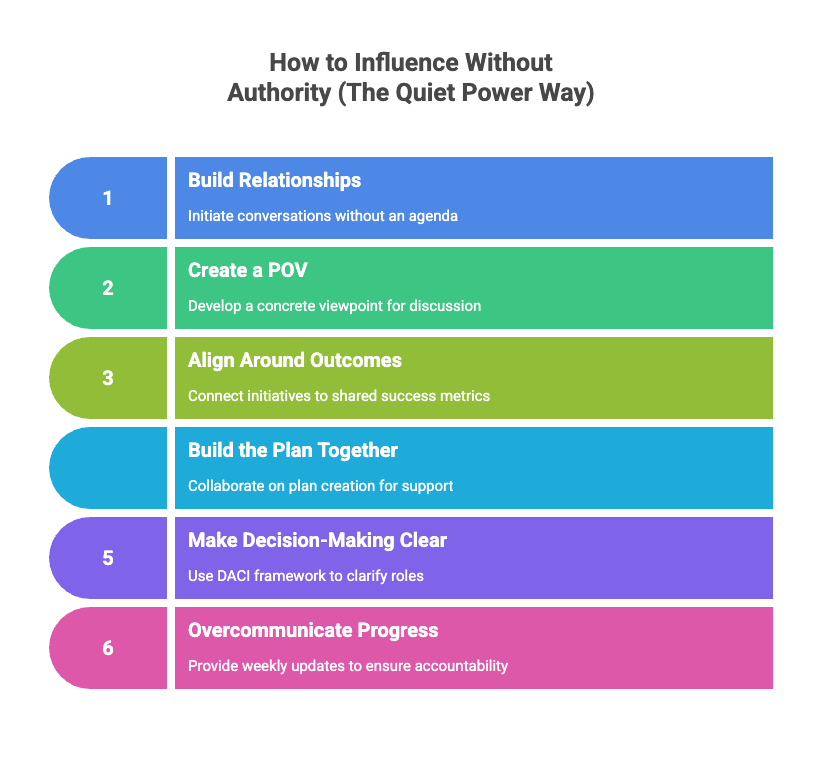How to build influence when you're not the one "in charge"
How to build influence when you're not the one "in charge"
Pull up your summer spreadsheet. You know the one—camps, pickups, half-days, travel. Now ask yourself: is there any time for YOU on there? Just like sunscreen protects your skin, a little reset time protects your mental health. That’s why I created Define Your Season of Ambition, a live workshop this Thursday, June 26, just for moms like us. So many of you have already signed up (you’re amazing!)—and if you haven’t yet, there’s still time to grab your spot and get the replay. We’re doing this together. 🎟️ Join us here.
I'm writing this in the rare pocket of time between work and camp pickup—those precious 5 minutes when I can actually chill. Summer is magical, but it's already kicking my butt. New schedules for the kids, sun not setting until nearly 9pm, which means lots of late bedtimes and way too many popsicles.
I'm trying to embrace the chaos and be less "planned"—go with the flow more. That mindset led to a beautiful moment yesterday where my kids chased bubbles for 40 minutes while I waited for my car to be washed. Sometimes the unplanned moments are the best ones.
Why being “Influential” isn’t being the Loudest
Speaking of going with the flow—ever watched someone with half your experience drive more change simply because they had the right relationships? Or felt your brilliant ideas get buried in committee while someone else's "good enough" proposal sailed through?
I spent years thinking influence was about being the loudest voice in the room. Turns out, the most powerful influence happens in the quiet moments—the 1:1 conversations, the strategic follow-ups, the thoughtful frameworks that make everyone else's job easier.
The Hidden Cost of "Waiting for Authority"
Here's what I see happening with ambitious moms in tech all the time: We wait. We wait for the "right" title. We wait for someone to hand us authority. We wait for permission to lead.
Meanwhile, our ideas stagnate. Projects we care about move forward without us. We watch less-experienced colleagues drive initiatives that should have been ours—not because they're better strategists, but because they understand how influence actually works.
This isn't about office politics or playing games. It's about recognizing that influence is a learnable system—one that works especially well for women who prefer building consensus over commanding attention.
The Quiet Power Framework: Six Steps to Influence Without Authority
After 15+ years leading cross-functional teams at Google and Adobe, I've distilled influence into a repeatable process. I call it the Quiet Power Framework because it works through connection, not control.
1. Build Relationships (Before You Need Anything) Start conversations with stakeholders when there's no agenda. Ask about their goals, challenges, and success metrics. The key: do this consistently, not just when you need something.
2. Create a POV -Something to React To Vague ideas die in committee. Specific proposals get feedback. Draft the strategy, mock up the solution, outline the timeline. Give people something concrete to improve rather than asking them to create from scratch.
3. Align Around Shared Outcomes Tie your initiative to their success metrics. Revenue growth. User adoption. Team efficiency. When your project helps others hit their numbers, resistance melts away.
4. Build the Plan Together Involve key stakeholders in shaping the approach. Ask for their input on timelines, resources, and potential roadblocks. People support what they help create.
5. Make Decision-Making Clear Use a DACI framework (Driver, Approver, Contributors, Informed) to clarify roles. Nothing kills momentum faster than unclear ownership or decision-making processes.
6. Manage Internal Comms + Overcommunicate Progress Send weekly updates. Share in key meetings. Repeat milestones and wins until people ask you to stop. Visibility creates accountability—and accountability creates results.
Think of influence like tending a garden rather than lighting a firecracker. It's consistent, intentional actions that compound over time.
Making It Real
Start today: Send one stakeholder a message asking to understand their quarterly goals better. That's it. No agenda, no ask—just genuine curiosity about their priorities.
This week: Map out your internal communications plan for your next project. What will you share, when, and with whom? Create a simple calendar of touchpoints.
Going forward: Schedule quarterly relationship check-ins with your key stakeholders. Fifteen minutes every three months prevents months of alignment struggles later.
One of my mentees, a senior product manager at a growth-stage startup, used this framework to drive adoption of a new customer research process across five different teams. She had zero formal authority over any of them, but by the end of the quarter, they were asking her to expand the program. The secret? She made their jobs easier and kept everyone informed along the way.
Your Permission Slip
You don't need a VP title to think strategically. You don't need direct reports to drive change. You don't need formal authority to lead.
What you need is a systematic approach to building the relationships and alignment that make change possible. The Quiet Power Framework gives you exactly that—a way to create momentum through connection rather than control.
What's one relationship you could strengthen this week that would help your current project succeed? Reply and let me know—I'd love to hear how you're applying this.
Remember: Leadership isn't about having all the answers. It's about creating the conditions where the right answers can emerge.
The most powerful influence often happens in the quiet moments. Make yours count.
xo,
Mary
P.S. If you found this helpful, forward it to another ambitious mom who's ready to stop waiting for permission to influence.



